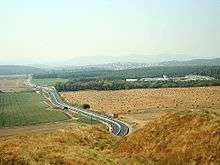Megiddo church (Israel)

- To be distinguished from the Megiddo Church in America (founded in 1880)
The ancient Megiddo church near Tel Megiddo, Israel is an archaeological site which preserves the foundations of one of the oldest church buildings ever discovered by archaeologists, dating to the 3rd century AD.[1]
Location
The remains were found at the Megiddo Prison, which is located a few hundred meters south of the tell and adjacent to Megiddo Junction in northern Israel. The area belonged to the ancient Roman town of Legio, known previously by its Hebrew name, Kefar ‘Otnay.[2]
Discovery and description
In 2005, Israeli archaeologist Yotam Tepper of Tel-Aviv University discovered the remains of a church, believed to be from the third century, a time when Christians were still persecuted by the Roman Empire. Among the finds is an approx. 54-square-metre (580 sq ft) large mosaic with a Greek inscription stating that "The god-loving Akeptous has offered the table to God Jesus Christ as a memorial."[3][4][5] The mosaic is very well preserved and features geometrical figures and images of fish, an early Christian symbol.[6]
An inscription in the Megiddo church mentions a Roman officer, "Gaianus," who donated "his own money" to have a mosaic made.
Dating debate
The anthropologist Joe Zias, former curator for the Israel Antiquities Authority, said "My gut feeling is that we are looking at a Roman building that may have been converted to a church at a later date."[7] On the other hand, persecution of Christians was sporadic in the Roman Empire during the early third century. The archaeological evidence may point to a later date, placing the church in the last quarter of the 3rd or first quarter of the 4th century.[8]
See also
- Legio, the Roman name of the town
- Lajjun, the Arabic name of the later village
- Oldest churches in the world
References
- ↑ E. Adams, The Ancient Church at Megiddo: The Discovery and an Assessment of its Significance, in The Expository Times, 2008. Quote: "... chronologically distinct. The structure at Megiddo is obviously not a basilica. According to Tepper, the Megiddo church is a unique ecclesiastical form. It could not have resembled the church buildings of the late third century."
- ↑ Yotam Tepper, Legio, Kefar ‘Otnay, in Hadashot Arkheologiyot: Excavations and Surveys in Israel, vol. 118, 2006
- ↑ Yotam Tepper, Leah Di Segni, A Christian Prayer Hall of the Third Century CE at Kefar 'Othnay (Legio): Excavations at the Megiddo Prison 2005. Israel Antiquities Authority, 2006, Jerusalem, Israel. Quote: "The Akeptous lnscription. The inscription is set within a rectangle (67 x 80 cm) in the western side of the southern mosaic panel. Its frame and letters are traced in black tesserae; the characters are 7.5-9.0 cm high."
- ↑ Andrew Lawler, First Churches of the Jesus Cult. Archaeology, 2007. Quote: "... Others are more intrigued. "I'm open to Megiddo as a third-century site," says Taylor. "It's idiosyncratic," she adds, since it does not fit the model of Christian churches during and after the time of Constantine. Those structures are easily recognizable by their basilica shape...."" Abstract of the article
- ↑ Andrew Lawler Full article
- ↑ Archaeologists unveil ancient church in Israel NBCnews.com
- ↑ Israeli Prisoners Dig Their Way to Early Christianity, New York Times, 7 Nov. 2005
- ↑ Vassilios Tzaferis, Oldest Church Found? Inscribed "To God Jesus Christ" Early Christian Prayer Hall Found in Megiddo Prison, Biblical Archaeology Review "Archived copy". Archived from the original on May 22, 2010. Retrieved June 2, 2010.
Coordinates: 32°34′16.2″N 35°11′28.7″E / 32.571167°N 35.191306°E